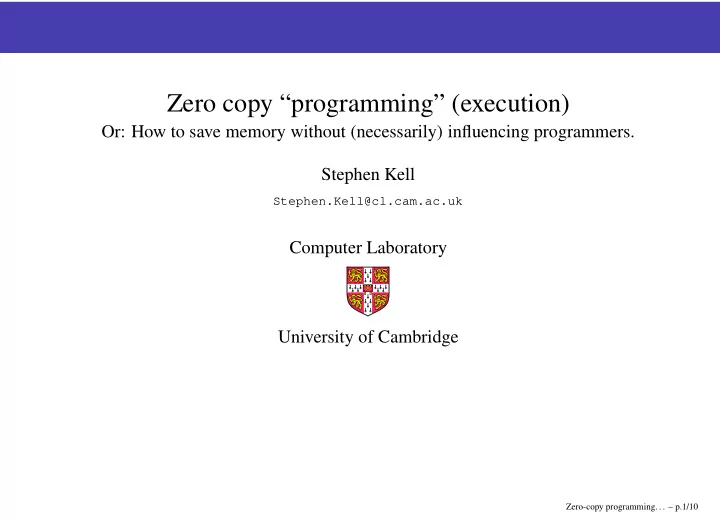

Zero copy “programming” (execution) Or: How to save memory without (necessarily) influencing programmers. Stephen Kell Stephen.Kell@cl.cam.ac.uk Computer Laboratory University of Cambridge Zero-copy programming. . . – p.1/10
Memory is scarce... Zero-copy programming. . . – p.2/10
Varnish versus Squid “Computers do not have two kinds of storage any more.” (Poul-Henning Kamp) � Don’t explicitly move data between disk and memory. � Intention: eliminate inefficient app–VM-subsys interaction � Bonus: smaller virtual memory footprint. Caveat: data must be identical on disk and memory ( verbatim copy ). Zero-copy programming. . . – p.3/10
Can we generalise? Uses a ton of memory storing on-disk data... but not verbatim . Zero-copy programming. . . – p.4/10
The plan We want to � avoid allocating memory... � ... if the contents can be reconstructed... � ... from other memory or memory-mappable storage. Levels of attack: � programmer behaviour � programming language definitions � programming language implementations � OS + runtime memory management Zero-copy programming. . . – p.5/10
First pass � “virtualise” culprit malloc() sites � ...no phys. mem is allocated, just faulting VAS region � on trap, use a lens on some backing data � program-demanded representation is still stored... � but only temporarily; made maximally ephemeral Problems: � characterise “reconstructed” (any computation?) � inferring lens logic (+ view update problem) � locality and page granularity � backing goes away � automatic [dynamic] analysis Zero-copy programming. . . – p.6/10
Outline dynamic analysis � identify backing data by trapping writes? But how? � maybe: say all new heap alloc is a “virtual region” � we may decide to downgrade it to a “physical region” later � virtual regions: “copy on unrepeatable write” � means guessing about the future (the usual OS trick) � backing regions: “copy on destructive write”? � If we guessed wrong above, may have to fork a copy :-( � Focus on malloc -sites causing high %age of usage Zero-copy programming. . . – p.7/10
Identifying lenses This is the really hard part. � Identify which functions write a virtual region � Trace them? Or just analyse instructions... � ...to check for purity � Cache these results (and re-evaluate?)... Simple example: sscanf() � on disk: " <key> = <value> ; \ n" � in memory: struct { int key; float value; } ; � read lens: sscanf(buf, "%d=%f \ n", &s.key, &s.value); � Know that sscanf() is pure, and buf available Zero-copy programming. . . – p.8/10
Conclusions (what?) Some questions I didn’t get time to answer. � How much saving are we talking? � Safety: I think purity is the key to safety... � What patterns of copying behaviour are common? � Is page granularity a problem? � Bidirectionality... Zero-copy programming. . . – p.9/10
Bonus: other applications Avoiding copy-to-memory enables coherent sharing of persistent objects. Zero-copy programming. . . – p.10/10
Recommend
More recommend